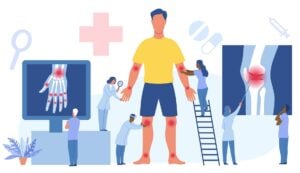

Ankylosing Spondylitis (AS) is a painful condition caused by inflammatory arthritis of the joints and ligaments of the spine (a form of spondyloarthritis – read more here). AS primarily affects the axial skeleton, which includes the entire spine, pelvis, rib cage and skull. The word “ankylosis” means abnormal stiffness and immobility of a joint due to bone fusion, and “spondylitis” means inflammation of the bones of the spine (vertebrae). Approximately 2% of Australians are affected, more males than females. AS usually begins before the age of 40.
The most common symptoms are aches and stiffness of the spine and hips that can extend to the neck, shoulders, rib cage and other joints over time. Pain and stiffness are worse in the morning or after rest and improve with activity or exercise.
In severe, long-standing cases, the vertebrate may fuse together and lead to a bent forward posture. The fused spine seen in AS patients is sometimes referred to as “bamboo spine”. Bone fusions can occur in other areas, such as the rib cage, which can affect breathing. In approximately 25% of affected people, the inflammation spreads to the eyes, causing pain and redness.
Diagnosis is based on symptoms, physical examination, blood tests and medical imaging.
The symptoms of AS are due to inflammation in the ligaments and joints. This damaging inflammation leads to erosion of bones and joints and abnormal bony growths, which can lead to vertebrae fusing together.

The actual disease itself is caused by a combination of things, the most significant of these, but not always the underlying cause, is genetics.
Numerous genes have been linked to AS, with most of those having roles in inflammation or regulation of the immune system, such as Human Leukocyte Antigens (HLAs) and Interleukins (ILs).
Unfortunately, there is no cure for AS, however it can be well controlled with the right treatment and management plan. Early diagnosis and treatment are key to improving symptoms and preventing advanced disease outcomes.
NSAIDs (i.e. ibuprofen, naproxen, diclofenac, celecoxib) may reduce inflammation and improve pain and stiffness.
DMARDs can be trialled if NSAIDs aren’t useful. They are designed to treat the underlying issues and may relieve arthritis symptoms and prevent joint damage. There are synthetic (conventional) and biological DMARDs. Biologics are recommended for AS and include the following:
An active lifestyle and regular exercise improves the symptoms and outcomes of AS. Studies have shown that regular exercise may reduce pain and disease activity and can help to prevent spinal fusions.
Joint replacement surgery (namely the hips) may be performed to restore functioning that has been lost due to inflammed and damaged joints.
Genesis Research Services conducts clinical trials for a range of painful conditions. To view currently recruiting studies or register your interest for future studies, click here or call us on (02) 4985 1860.
View our currently recruiting studies:
Register your interest for future studies:
© Genesis Research Services, 2023